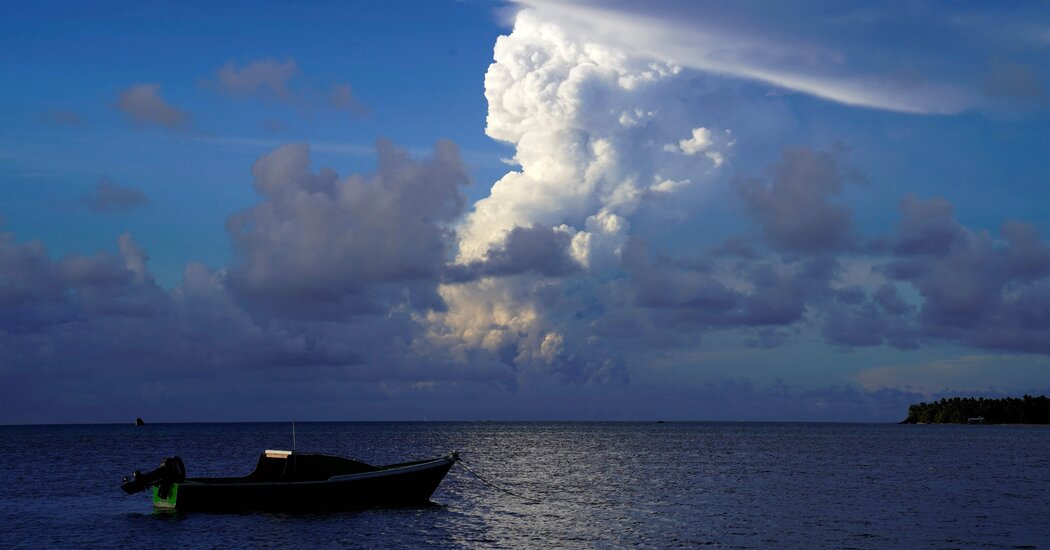A four-foot tsunami wave was reported to have hit Tonga’s capital, Nuku’alofa, on Saturday, sending people rushing to higher ground. Witnesses said ash had fallen from the sky, after an underwater volcano erupted earlier near the remote Pacific nation.
The volcano, Hunga Tonga-Hunga Ha’apai, is about 40 miles north of the Pacific archipelago’s main island, Tongatapu.
The Bureau of Meteorology in Australia reported the tsunami on Twitter. But communication with Tonga was disrupted, according to The Associated Press, so there were no immediate official reports of injuries or the extent of the damage.
The Tonga Meteorological Service issued a tsunami warning for the archipelago on Saturday evening. On their Facebook pages, the meteorological services for nearby Fiji and Samoa also issued alerts, advising people to stay away from low-lying coastal areas.
The National Tsunami Warning Center in the United States issued a tsunami advisory for the West Coast on Saturday morning Pacific time, including the Washington and Oregon coast, with the National Weather Service in Portland reporting possible one- to three-foot waves in Newport, Ore., Long Beach, Wash., and Seaside, Ore. “First wave may not be the highest,” and later waves may “be larger,” the tweet said.
By 8:30 a.m., water levels rose to six feet in Monterey, Calif., and in San Francisco, with higher levels expected later in the day. The tsunami would affect “our coast and bays over the course of several hours, and the highest water levels may not arrive until hours after onset,” the local National Weather Service said on Twitter.
The surges off the coast were expected to be similar to those during high tide rather than as large cresting waves, it said.
The volcano had been relatively inactive for several years, but it began erupting intermittently in December. By Jan. 3 the activity had decreased significantly, according to a report by the Smithsonian Institution’s Global Volcanism Program.
In 2014, the volcano erupted, spawning a new island that eventually became home to blossoming vegetation and barn owls, according to the BBC.
Satellite imagery of the eruption on Saturday, shared on Twitter by New Zealand’s National Institute of Water and Atmospheric Research, showed a “brief spike in air pressure as the atmospheric shock wave pulsed across New Zealand.”
Other recent infrared satellite imagery suggested that the underwater volcano was still erupting, and despite Tonga’s geographical isolation, a booming sound was heard after the initial eruption as far as New Zealand (which is 1,100 miles northeast of Tongatapu) according to Weather Watch, a private weather forecaster in the country.
The eruption Saturday sent a plume of gases and ash about 12 miles (20 kilometers) into the atmosphere, according to early reports.
New Zealand’s National Emergency Management Agency issued a statement on Saturday, advising people in the coastal areas to expect “strong and unusual currents and unpredictable surges at the shore.”
In a thread on Twitter, Dr. Janine Krippner, a volcanologist at the Smithsonian Institution, said that “the majority of the volcano is submarine.”
The strength and potential impact of an eruption is estimated using a volcanic explosivity index, or V.E.I., which takes into account the volume of material ejected during the eruption and how high the plume reaches. The V.E.I. of the eruption Saturday has not been estimated yet, but before the eruption, the volcano was estimated to be able to produce an eruption with a maximum V.E.I. of 2.
Eruptions with a V.E.I. of 6 or higher send so much gas and particles so high into the atmosphere that they can have a cooling effect on the climate for several years, by reflecting more sunlight away from the Earth’s surface. But eruptions of that magnitude occur very rarely. The latest was Mount Pinatubo in the Philippines in 1991.
Henry Fountain contributed reporting.





